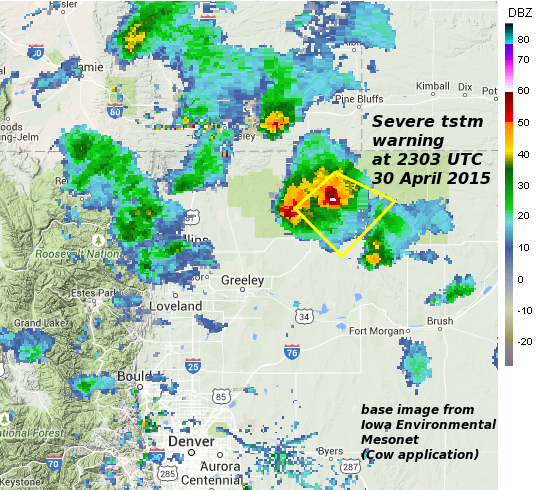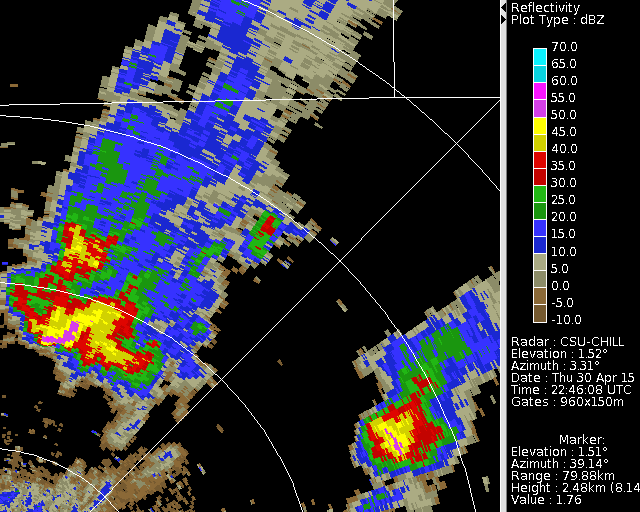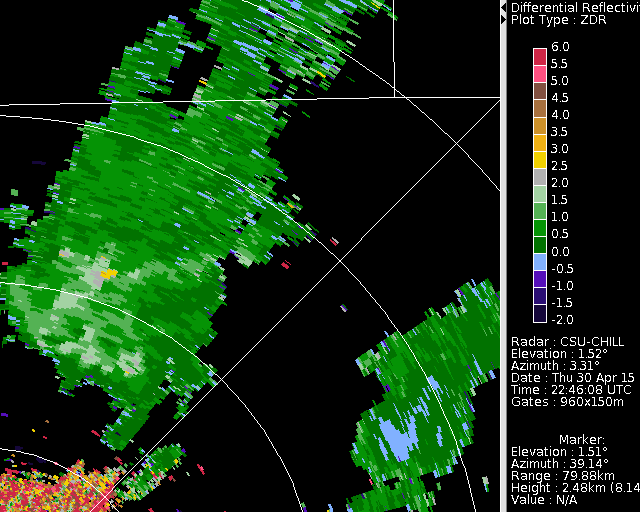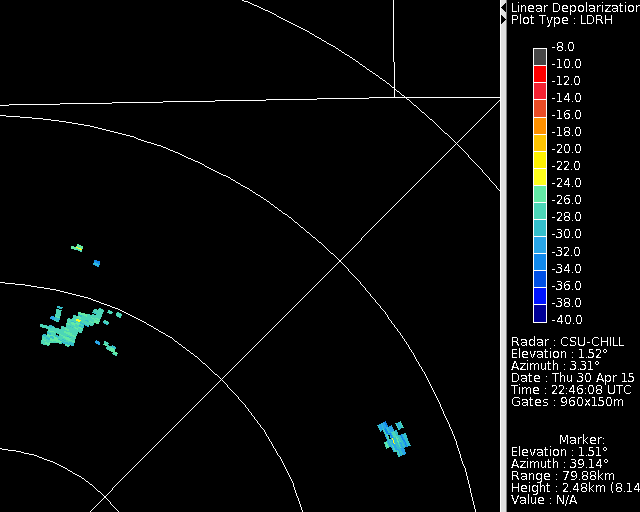DPWX/Onset of dual polarization hail indications: 30 April 2015: Difference between revisions
Pat kennedy (talk | contribs) No edit summary |
Pat kennedy (talk | contribs) No edit summary |
||
| Line 1: | Line 1: | ||
== Overview== | |||
During the late afternoon hours of 30 April 2015, the CSU-CHILL radar was conducting test operations that included continuous 360 degree surveillance scans at a fixed elevation angle of 1.5 degrees with a scan rate of 4 deg per second. This scan regime produced new data files at ~1.5 minute intervals. (Each sweep is slightly more than a full revolution to ensure complete azimuthal coverage). While these scans were in progress, the appearance of dual-polarization indications of hail in a developing thunderstorm was recorded. The Denver / Boulder NWS forecast office issued a severe thunderstorm warning for this storm at 2303 UTC / 1703 MDT: | |||
[[Image:30apr2015 warning box anot 2.png|center]] | [[Image:30apr2015 warning box anot 2.png|center]] | ||
==Reflectivity loop== | ==Reflectivity loop== | ||
The following loop shows the CSU-CHILL reflectivity data for the 2244 - 2315 UTC period. The hail-bearing reflectivity core in the eastern portion of the echo system appeared and quickly reached an intensity of ~60 dBZ within a 10 minute time period as hydrometeors that had developed aloft descended into the 1.5 degree elevation angle scan plane. | |||
<center> | <center> | ||
| Line 32: | Line 36: | ||
==Differential reflectivity loop== | ==Differential reflectivity loop== | ||
The next loop shows the differential reflectivity (<math>Z_{dr}</math>) data from the sweeps that were used in the preceeding reflectivity loop. The red circle highlights the echo core region where <math>Z_{dr}</math> is reduced to ~ 0 dB. <math>Z_{dr}</math> is defined as 10 log10 (Zh / Zv) where Zh and Zv are the reflectivities observed at horizontal and vertical polarizations respectively. The approximately spherical hailstone shapes in combination with their quasi-randome tumbling motions tend to equalize Zh and Zv; a Zh / Zv ratio of 1 results in a <math>Z_{dr}</math> value of 0 dB. In contrast, the net forces acting on falling raindrops produce flattened drop shapes that preferentially increase Zh relative to Zv. Thus, precipition areas that are primarily composed of raindrops are characterized by positive <math>Z_{dr}</math> values (Wakimoto and Bringi, MWR 1989 p. 1521-1539.) In the image loop, <math>Z_{dr}</math> levels decrease from ~ +1.5 dB to ~ 0 dB as the hailstones became an increasingly significant precipitation component in the echo core. | |||
<center> | <center> | ||
| Line 61: | Line 66: | ||
==Linear depolarization ratio loop== | ==Linear depolarization ratio loop== | ||
<center> | <center> | ||
<imgloop delay=300 imgprefix="http://www.chill.colostate.edu/anim/30apr2015_hail_development/" width=640 height=512> | <imgloop delay=300 imgprefix="http://www.chill.colostate.edu/anim/30apr2015_hail_development/" width=640 height=512> | ||
Revision as of 12:00, 20 May 2015
Overview
During the late afternoon hours of 30 April 2015, the CSU-CHILL radar was conducting test operations that included continuous 360 degree surveillance scans at a fixed elevation angle of 1.5 degrees with a scan rate of 4 deg per second. This scan regime produced new data files at ~1.5 minute intervals. (Each sweep is slightly more than a full revolution to ensure complete azimuthal coverage). While these scans were in progress, the appearance of dual-polarization indications of hail in a developing thunderstorm was recorded. The Denver / Boulder NWS forecast office issued a severe thunderstorm warning for this storm at 2303 UTC / 1703 MDT:

Reflectivity loop
The following loop shows the CSU-CHILL reflectivity data for the 2244 - 2315 UTC period. The hail-bearing reflectivity core in the eastern portion of the echo system appeared and quickly reached an intensity of ~60 dBZ within a 10 minute time period as hydrometeors that had developed aloft descended into the 1.5 degree elevation angle scan plane.
|
|
||
|
Differential reflectivity loop
The next loop shows the differential reflectivity () data from the sweeps that were used in the preceeding reflectivity loop. The red circle highlights the echo core region where is reduced to ~ 0 dB. is defined as 10 log10 (Zh / Zv) where Zh and Zv are the reflectivities observed at horizontal and vertical polarizations respectively. The approximately spherical hailstone shapes in combination with their quasi-randome tumbling motions tend to equalize Zh and Zv; a Zh / Zv ratio of 1 results in a value of 0 dB. In contrast, the net forces acting on falling raindrops produce flattened drop shapes that preferentially increase Zh relative to Zv. Thus, precipition areas that are primarily composed of raindrops are characterized by positive values (Wakimoto and Bringi, MWR 1989 p. 1521-1539.) In the image loop, levels decrease from ~ +1.5 dB to ~ 0 dB as the hailstones became an increasingly significant precipitation component in the echo core.
|
|
||
|
Linear depolarization ratio loop
|
|
||
|



